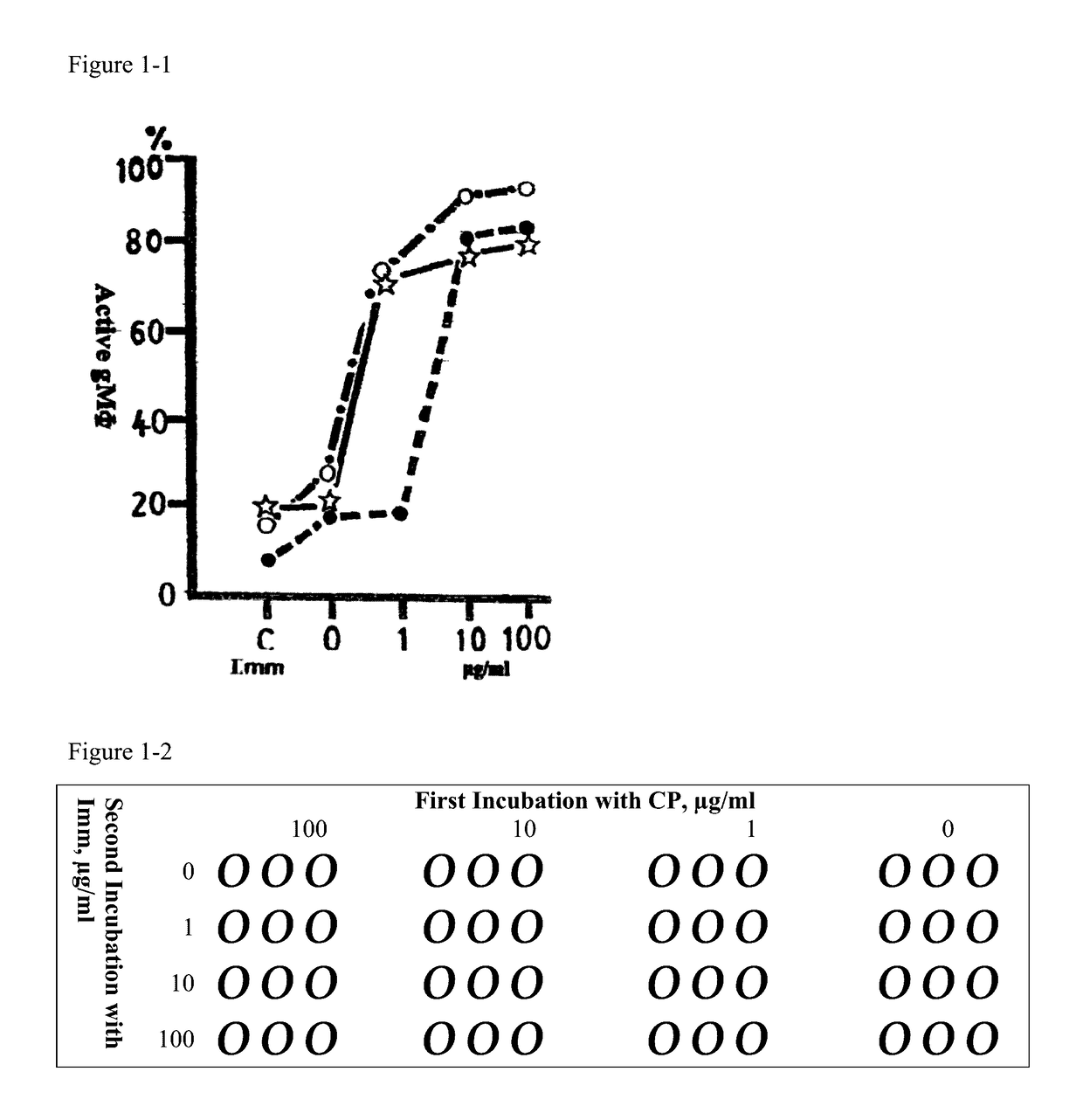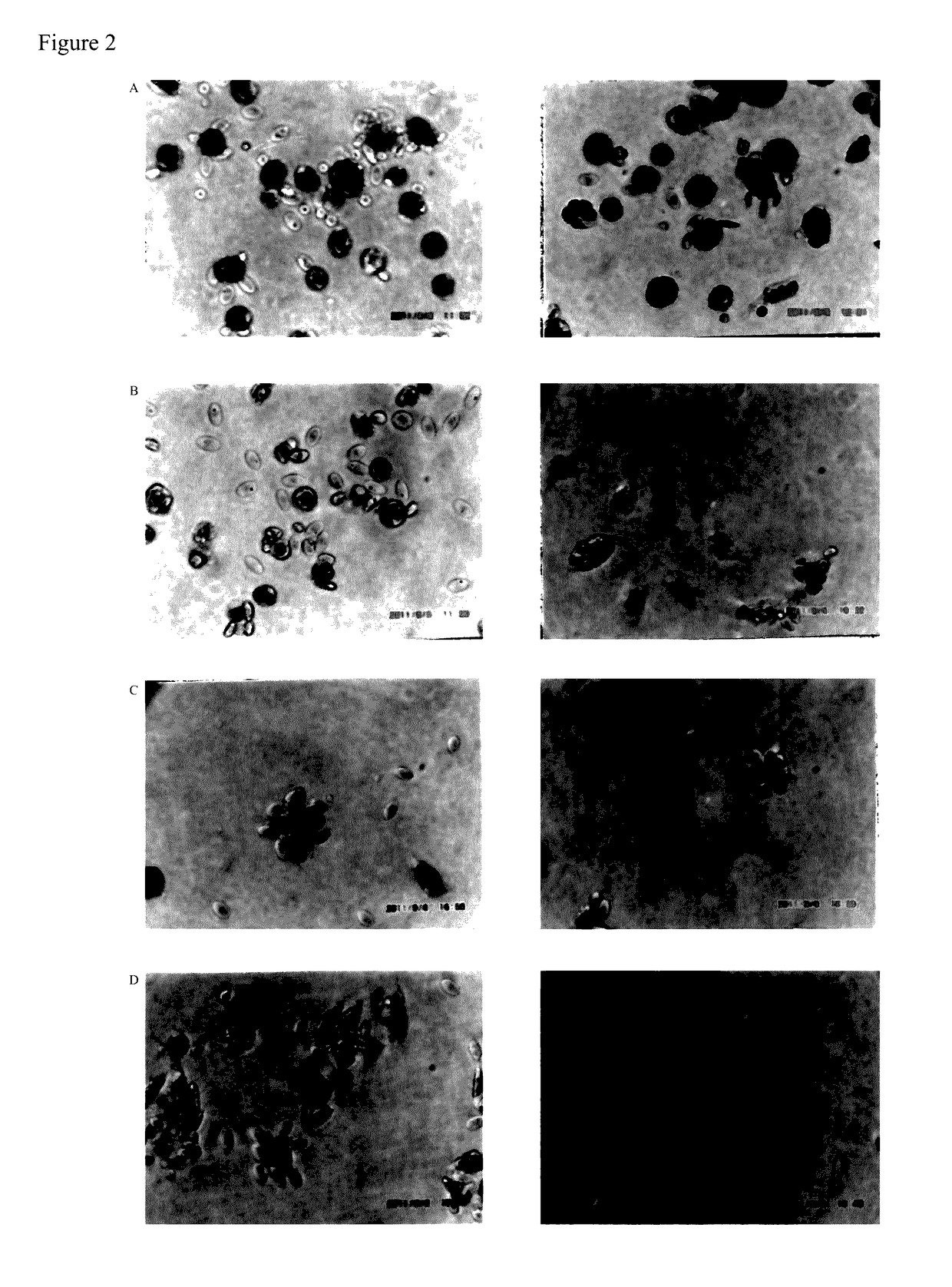Useful process for screening immune response modifier
a technology of immune response and process, applied in the direction of material analysis, plant/algae/fungi/lichens ingredients, instruments, etc., can solve the problems of lysis effect, inadequate amount of antibody produced to activate antibody-dependent cytotoxic cells (adcc), and extremely difficult cure of aids, etc., to inhibit hiv replication, good curative effect, and good curative
- Summary
- Abstract
- Description
- Claims
- Application Information
AI Technical Summary
Benefits of technology
Problems solved by technology
Method used
Image
Examples
experiment 1
[0018]Effect on cellular immunity in vitro:
[0019]The effector (killer) cells for this experiment were adherent macrophages (gMφ) derived from guinea pig's peritoneal fluid cultured with R7½G (RPMI 1640 enriched with 7.5% v / v guinea pig serum). Cyclophosphamide (CP) was used as an immunosuppressive agent. Chicken red blood cells (cRBC) as target cells.
[0020]The experiment consisted of four series of experiments: gMφ+cRBC, gMφ+Imm+cRBC, gMφ+CP+cRBC, and gMφ+CP+Imm+cRBC, and immunovir (Imm) as immune response modifier.
[0021]A 200 to 250 g guinea pig was injected with 1 mL of thioglycolate medium, after 20 hours adherent macrophages derived from abdominal cavity (gMφ) were collected by aid of RPMI 1640, suspended in R7½G, then 0.9 mL of solution was pipetted into thirteen Falcon 12-well culture plates. The plates for group 1 and 2 to group 4 were 1 and 3, respectively. See FIG. 1-2. Cyclophosphamide (CP) was added into the wells from group 2 to group 4 so that the final concentration wa...
experiment 2
[0024]Effect of mice macrophages / mononuclear cells activities in vivo.
[0025]Mice were injected with cyclophosphamide 200 mg / kg.b.w and 100 mg / kg.b.w via tail vein in the morning of day 1 and day 2, respectively. Two mice of each group were injected with 10 mg / kg.b.w of immunovir (O, mixture), immunovir A, B, C, D, or 20 mg / kg.b.w of AZT via tail vein in the afternoon from day 2 to day 5, respectively. Each mouse's abdominal cavity was injected with 0.5 mL of R7½C in the afternoon of day 5, and mMφ / / Mo were collected from each mouse's abdominal cavity with 10 mL of R7½C in the afternoon of day 6. Basal medium rich in deposit cells were taken, and 0.40 mL was pipetted into two wells of flat-bottomed 24-well Falcon culture dish. After incubation with 5% CO2 for 6 hours, 0.10 mL of cRBC (1%) was added into each well and incubation was carried out for 6 hours or overnight. Then suspended cells, i.e., cRBC, were sucked out, the well was gently washed with 0.5 mL of RPMI 1640, and 0.40 mL ...
experiment 3
[0026]The efficacy of immunovir to mononuclear killer cell activity derived from mouse's spleen:
[0027]Twenty male BALB / c mice aged 8 weeks were divided into group A, B, C, and D. Mice in group A were injected with 0.20 mL of normal saline intravenously. Group B received cyclophosphamide (CP) 200 mg / kg.b.w and 100 mg / kg.b.w at day 1 and day 2, and subsequently, received normal saline every day. Group C received immunovir 10 mg / kg.b.w every day. Group D received CP as group B and immunovir as Group C. All mice's spleens were excised at day 7 and spleen-derived mononuclear cells were isolated by Ficol-paque centrifugation.
[0028]Yac-1 cells (2×106 / mL) were labeled with R20C containing 1 uc / mL of 51Cr-chromate for 60 minutes at 37° C.
[0029]Mouse's spleen-derived mononuclear cells (killer cells) (3×106) and 51Cr-chromate-labeled Yac-1 cells (6×106) were suspended altogether in 1.0 mL of R20C medium and incubated at 37° C. for 150 minutes, centrifuged with 250 g for 10 minutes, then 0.50 m...
PUM
| Property | Measurement | Unit |
|---|---|---|
| concentration | aaaaa | aaaaa |
| concentration | aaaaa | aaaaa |
| concentration | aaaaa | aaaaa |
Abstract
Description
Claims
Application Information
 Login to View More
Login to View More - R&D
- Intellectual Property
- Life Sciences
- Materials
- Tech Scout
- Unparalleled Data Quality
- Higher Quality Content
- 60% Fewer Hallucinations
Browse by: Latest US Patents, China's latest patents, Technical Efficacy Thesaurus, Application Domain, Technology Topic, Popular Technical Reports.
© 2025 PatSnap. All rights reserved.Legal|Privacy policy|Modern Slavery Act Transparency Statement|Sitemap|About US| Contact US: help@patsnap.com



